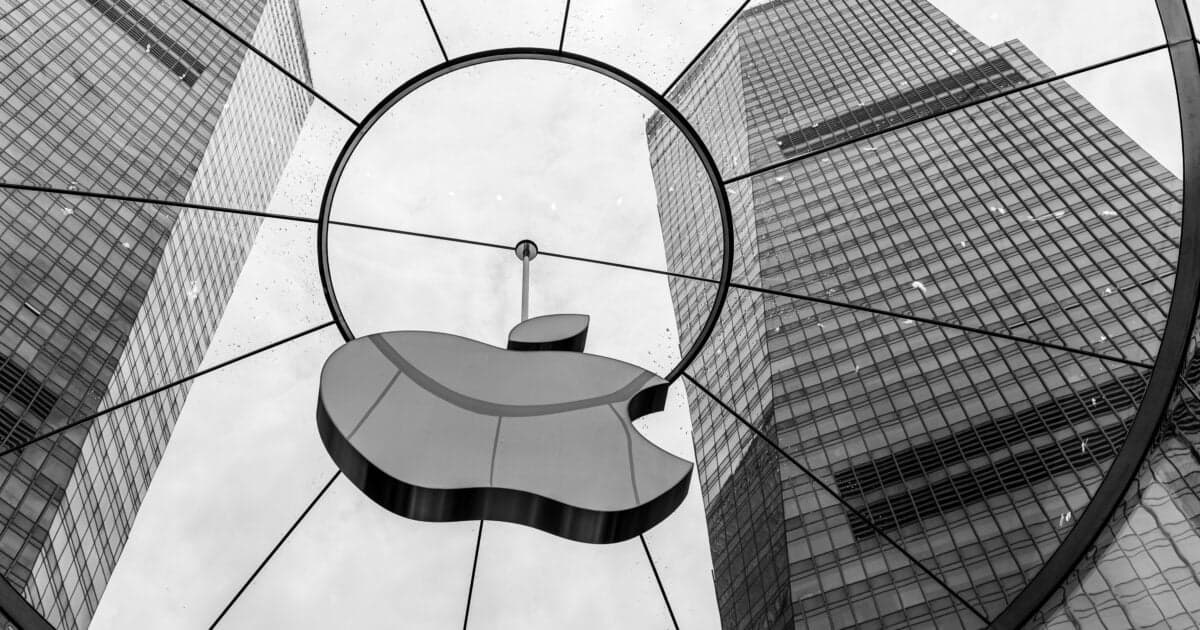Apple's $600B Bet: Can Infrastructure and AI Reignite AAPL Stock?


In February, Apple (AAPL) CEO Tim Cook pledged to invest $500 billion (over four years) in American manufacturing, suppliers, and research and development (R&D). Part of these plans included the construction of a new factory in Houston, which would manufacture services for Apple Intelligence. This agreement with President Donald Trump also involved the expansion of existing Apple U.S. operations as well as partnerships across other states.
Then, in August, Cook offered another $100 billion in American investments through, in Apple's words, the "ambitious" American Manufacturing Program ("AMP")... designed to bring even more of Apple's manufacturing and supply chain to the U.S.
On the surface, this all seems like very promising news for both Apple and America. Plus, Apple announced record revenue and double-digit growth for iPhone, Mac, and Services in Q3 2025.
So why has legendary investor Warren Buffett sold around 950 million of Berkshire Hathaway's Apple shares over the past couple of years?
Given Apple's recent performance and prolific track record, it was a fascinating decision.
And what does Buffett's sell-down mean for investors and the Apple stock forecast? Buy, hold, or sell?
Let's examine...
Apple's $600 Billion U.S. Infrastructure Push
As we covered, Apple hedged a $600 billion bet on American infrastructure for Apple products and services. The strategy behind this investment comprises:
- Supply chain stability: More American manufacturing means less reliance on overseas production... and no Trump tariffs eating into Apple's bottom line.
- AI innovation and growth: Apple was a decidedly late entrant into the world of AI. The investment in American AI R&D hubs and services may ultimately help Apple gain ground on its competitors in the AI space.
- Benefits of reshoring: Bringing the manufacturing of critical tech components to the U.S. leads to American economic and national security, according to the federal government.
- Reduction of geopolitical risk: A strong Apple supply chain in America minimizes the country's reliance on China for parts and assembly. Lessening exposure to China protects Apple from not only tariffs but also shifts in foreign policy and further trade tension between the two countries.
Beyond its strategic components, Apple's investment in America is just good business. Apple's AMP is expected to create 20,000 new, direct American jobs in research and development, manufacturing, AI engineering, and software development... not even factoring in the potential thousands of indirect jobs and an expansion of existing roles within Apple.
The White House and Apple also expect this program to boost America's economy. Establishing an Apple infrastructure in the U.S. is a critical piece of this investment. Along with the new manufacturing facility in Houston, Apple recently reached an agreement with Corning (GLW) for the American glass giant to produce 100% of the cover glass for iPhones and Apple Watches in its Kentucky plant.
Cook also announced that Apple would develop and build semiconductors and related equipment in Arizona, Texas, and New York through partnerships with GlobalWafers and Taiwan Semiconductor Manufacturing (TSMC), which has chip fabs in Phoenix, Arizona. These states, plus Kentucky, expect these direct infrastructure investments to result in more supplier orders and more jobs.
Naturally, these initiatives and investments improve investor confidence. The prospect of American innovation (especially AI), a strong domestic supply chain, an established infrastructure, job growth in the U.S., and the avoidance of tariffs led Apple's stock to spike 5% the day the company announced its $100 billion investment expansion.
The Contradiction: Growth Slowdown and Buffett's Exit
Then why has Warren Buffett divested Berkshire Hathaway from nearly one billion Apple shares since 2023? Buffett brought up the following two points:
- Concentration risk: At one time, Apple represented nearly half of Berkshire's equity holdings. Selling Apple shares helped Berkshire significantly cut its concentration risk.
- Tax reasons: Cashing in when Buffett did – when the peak corporate income tax rate was historically low – made the sale more profitable.
But the two biggest drivers of Buffett's Apple sell-down – and a persisting concern for analysts and investors – are Apple's recent stagnant growth and its valuation.
Slowing growth
Though Apple did show impressive growth in Q3 2025 with a record $94 billion in revenue (a 10% year-over-year increase), Apple's earnings and device sales have been roller-coaster-like since 2019. While its services revenue (the App Store and its vast ecosystem, Apple Music, iCloud, Apple Pay) and revenue from non-iPhone devices like AirPods and Apple Watches experienced sustained growth, iPhone sales have stagnated in recent years. That matters because the iPhone still accounts for more than half of Apple's revenue, representing 51% of the total haul last year.
In its May 2024 earnings call, Apple revealed its steepest quarterly decline in iPhone sales since the start of the pandemic. iPhone sales plummeted 10% year-over-year during Q2 2024... its biggest decline since Q2 2020, when pandemic-related factory shutdowns bottlenecked iPhone production. Apple's Q2 2024 slump was the fifth consecutive quarter that revenue slid from the previous year.
Reflective of its recent up-and-down performance, however, iPhone revenue soared by 13% year-over-year during Q3 2025, driven by somewhat strong demand for the iPhone 16 base model (sales were sluggish for the iPhone 16 Pro and Pro Max models). Apple's Mac business grew significantly, with the M4 MacBook Air and Mac Mini fueling a 15% year-over-year ("YOY") revenue increase.
And the just-released iPhone 17 may be just what Apple needs to sustain its recent momentum. As the newest model finally hits stores and orders start shipping – and as demand for iPhone 17 reverses course and grows in China – Apple stock is rallying yet again.
Make no mistake, Apple is an outstanding company and a profit machine. Look no further than our proprietary Stansberry Score, which gives Apple an impeccable A+ overall rating thanks to its elite financials and capital efficiency.
If there's one nit to pick, however, it's Apple's valuation, which we grade a C.
Valuation concerns
Perhaps Buffett's biggest concern was Apple's stock valuation, which some analysts and investors deem overvalued relative to its slowing profit growth.
Whitney Tilson agrees. In fact, he's not a fan of Apple stock for one simple reason...
"Apple is priced as if it's a growth company... but it's not."
Tilson points to Apple's net income and revenue over the past decade. Besides a COVID-fueled burst of growth, top and bottom lines have been stagnant for about four years now:
Whitney goes on to compare Apple's stock performance with four other members of tech's "Magnificent Seven": Amazon (AMZN), Microsoft (MSFT), Alphabet (GOOGL), and Meta Platforms (META).
Read Whitney's analysis to understand why Apple is a negative outlier among the other tech giants.
To sum up Apple's valuation in Whitney's words, "Apple is an insanely great company and generates gobs of cash. But it has stopped growing – and I don't think that's going to change much."
Is Apple Stock a Buy, Hold, or Sell?
Apple stock certainly provides investors with plenty to consider. Let's jump into both the bullish and bearish arguments for Apple and figure out whether it's worth buying.
The bullish case
There are always reasons to be bullish on Apple... Tim Cook's $600 billion investment in American manufacturing and research is just the latest.
- Apple Services: Apple's Services segment hit a record-high $27.4 billion in revenue in Q2 2025... a 13.3% YOY increase. And because the Services segment is high in margin, Apple's total gross margin soared to a record 46.9% in January. The stickiness of Apple's App Store, Apple Music, and iCloud ecosystem helps insulate the business from customer attrition.
- AI expansion (finally): Apple's late arrival to the AI space allowed its competitors – namely Google – to capitalize on the AI boom with deeply embedded AI integration into their phones. Well, Apple is now significantly increasing capex (more on that later) to invest in AI – prioritizing privacy in its new technologies – including Private Cloud Compute as well as data centers. Its mission to integrate Apple Intelligence AI and its on-device processing, which keeps data private on your device, into its product ecosystem is a critical (and expensive) one.
- Potential iPhone 17 supercycle: Wedbush estimates that between 315 million and 1.5 billion global users have not upgraded their phones in the past four years. That passive behavior indicates that iPhone 17 is in for big sales. Early indicators confirm that demand, with product wait times already exceeding iPhone 16 at launch.
- Exciting new devices: On the horizon are the new Apple Vision Pro augmented reality/virtual reality headset as well as – possibly – a foldable iPhone to compete with Samsung's popular Galaxy Z Fold phones.
- Consistently strong financial foundation and capital returns: Free cash flow is never an issue for Apple, as it generates around $100 billion annually. This serves as a nearly bottomless well of capital from which investments in product innovation, dividends, and share buybacks can be drawn. And Apple certainly does participate in massive share buybacks on the regular... usually repurchasing about $100 billion a year.
The bearish case
Even with plenty of Apple optimism, some investors are proceeding cautiously with Apple shares. Here's why:
- Increasing production costs: The shift in production to the United States may result in higher manufacturing costs, which not only erodes Apple's bottom line but also potentially impacts product pricing and, thus, market competitiveness.
- High capex: As we mentioned, Apple's capex is exploding... its capital expenditures for Q3 2025 were $3.46 billion, a massive YOY jump from $2.15 billion. And that spending is projected to grow even more over the next five years. Apple's $600 billion investment in America is one reason why. Also factoring into the increase is the investment in its own first-party AI data centers and their Private Cloud Compute infrastructure. Those data centers are necessary because of Apple's steady push to integrate AI into its entire ecosystem... an expensive endeavor.
- Execution risks: Apple's $600 billion U.S. investment is, as the company stated itself, ambitious. While the long-term payoff could be massive, a plan of this magnitude always runs the risks of product or construction delays, cost overruns, and even manufacturing slowdowns. Bringing this level of high-skill manufacturing and production to America is admirable... but it also requires extensive employee training to ensure that operations and finished products and technologies meet Apple's high standards. Even slight delays open the door for competitors to push their products to market.
- The Warren Buffett sell-down: When the "Oracle of Omaha" makes a move, the market pays close attention. Buffett's sale of nearly a billion Apple shares was no exception. And while Buffett had his own reasons for the sale (he still firmly believes in Apple and owns several million shares), the transaction raised a few red flags, particularly concerning Apple's share valuation.
There may be some short-term headwinds – making up lost ground in AI technology, increased production costs, notably high capex for the foreseeable future, possible iPhone stagnation – but the long-term outlook for Apple remains solid.
Its margins are quite strong, especially in its Services segment... and that segment has helped Apple keep billions of subscriptions active on billions of devices globally. Their ecosystem is very sticky, which encourages repeat device purchases and subscription renewals. And Apple is, at long last, getting involved in the AI game, with new services and devices on the way.
Free cash flow is never an issue for Apple, and it's nearly always at the forefront of R&D and product innovation... and that keeps its intensely loyal customer base consistently excited for new product launches and announcements. Though it has its challenges (name a business that doesn't), Apple remains the envy of most brands around the world.
Despite its challenges, the Apple stock forecast looks sunny... or at least partly sunny. Apple is primed for a strong finish to 2025, driven by iPhone 17 sales (especially an uptick of orders in China), a potentially strong domestic supply chain, and the continuing embedding of Apple's AI technology into its devices.
Bottom Line: Is Apple Stock a Good Investment?
The $600 billion American infrastructure investment is likely to result in some near-term volatility and a potential growth slowdown until Apple's data centers are up and running and production at its new and future manufacturing facilities ramps up. But once Apple's operations start humming, it should be a force to be reckoned with over the next decade or so.
But as for the stock today, we're inclined to agree with Whitney's analysis and our proprietary Stansberry Score. Apple is a great business. Nobody can dispute that. But even great businesses can make for bad investments when you overpay for them.
At 34 times current earnings, AAPL looks historically expensive. In fact, using this valuation metric, it's only been more expensive twice in the past 10 years – during the postelection bump of 2024 and the boom years of 2020 and 2021. Apple is pricier than its historic levels and also the broader market. The S&P 500 Index currently trades around 30.7 times earnings.
That premium valuation might be warranted if the company were growing its bottom line quickly. But, as Whitney showed above, net income has been stagnant for some time.
Our prognosis on AAPL: Amazing business, but there are possibly better buying opportunities ahead.
Regards,
David Engle
Editor’s Note: To truly harness market opportunities like Apple's infrastructure push and AI evolution – and to interpret moves like Buffett's sell-down – you'll want a time-tested framework. Whitney Tilson's N.E.W. Wealth System lays out the rules of "when to buy, when to hold, and when to sell" – backed by decades of classic wisdom and modern market scenarios.
Click here to learn how the N.E.W. Wealth System helps smart investors stay ahead – and not get swept away by the headlines.





